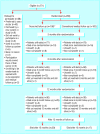Nurse led follow up and conventional medical follow up in management of patients with lung cancer: randomised trial
- PMID: 12433764
- PMCID: PMC133453
- DOI: 10.1136/bmj.325.7373.1145
Nurse led follow up and conventional medical follow up in management of patients with lung cancer: randomised trial
Erratum in
- BMJ 2002 Dec 14;325(7377):1386
Abstract
Objective: To assess the effectiveness of nurse led follow up in the management of patients with lung cancer.
Design: Randomised controlled trial.
Setting: Specialist cancer hospital and three cancer units in southeastern England.
Participants: 203 patients with lung cancer who had completed their initial treatment and were expected to survive for at least 3 months.
Intervention: Nurse led follow up of outpatients compared with conventional medical follow up.
Outcome measures: Quality of life, patients' satisfaction, general practitioners' satisfaction, survival, symptom-free survival, progression-free survival, use of resources, and comparison of costs.
Results: Patient acceptability of nurse led follow up was high: 75% (203/271) of eligible patients consented to participate. Patients who received the intervention had less severe dyspnoea at 3 months (P=0.03) and had better scores for emotional functioning (P=0.03) and less peripheral neuropathy (P=0.05) at 12 months. Intervention group patients scored significantly better in most satisfaction subscales at 3, 6, and 12 months (P<0.01 for all subscales at 3 months). No significant differences in general practitioners' overall satisfaction were seen between the two groups. No differences were seen in survival or rates of objective progression, although nurses recorded progression of symptoms sooner than doctors (P=0.01). Intervention patients were more likely to die at home rather than in a hospital or hospice (P=0.04), attended fewer consultations with a hospital doctor during the first 3 months (P=0.004), had fewer radiographs during the first 6 months (P=0.04), and had more radiotherapy within the first 3 months (P=0.01). No other differences were seen between the two groups in terms of the use of resources.
Conclusion: Nurse led follow up was acceptable to lung cancer patients and general practitioners and led to positive outcomes.
Figures
References
-
- Kievit J, Bruinvels DJ. Detection of recurrence after surgery for colorectal cancer. Eur J Cancer. 1995;31A:1222–1225. - PubMed
-
- Rosselli Del Turco M, Palli D, Carridi A, Ciatto S, Pacini P, Distante V. Intensive diagnostic follow-up after treatment of primary breast cancer: a randomised trial. JAMA. 1994;271:1593–1597. - PubMed
-
- GIVIO Investigations. Impact of follow-up testing on survival and health related quality of life in breast cancer patients. JAMA. 1994;271:1587–1592. - PubMed
Publication types
MeSH terms
LinkOut - more resources
Full Text Sources
Medical

